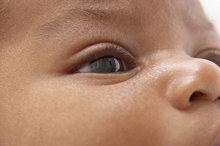Visual Perception Problems in Children
Visual perception is defined as the ability of the eye to take in information and interpret it. It is not just seeing, but translating visual images into information that the brain can remember, organize, recognize and use. It allows children to understand what an image means, such as shape and letter recognition, According to optometrists Michele Bessler and Martin Birnbaum, one in four children have visual problems, including visual perception issues, that can affect academic performance.
Impact
Visual perceptual problems can impact many areas of academic performance in children. In reading, children may experience difficulty in recognizing letters that are similar or words that they have seen before. Spelling can be impacted with visual perceptual problems, as children often reverse letters and numbers. Interpreting math symbols, charts, maps, graphs and diagrams can also be difficult. Lastly, handwriting and left/right discrimination for fine motor and gross motor activities can also be affected by visual perceptual problems.
- Visual perceptual problems can impact many areas of academic performance in children.
- Lastly, handwriting and left/right discrimination for fine motor and gross motor activities can also be affected by visual perceptual problems.
Components
Activities to Promote Perceptual & Motor Skills
Learn More
Components of visual perception include visual discrimination, visual memory, spatial relations and visual motor integration. Visual discrimination is the ability to see differences or similarities in objects, shapes and signs, while visual memory allows a child to remember the shape, size and location of an object. Spatial relations with respect to visual perception refers to a child’s ability to see something and understand its relationship to the surrounding space -- such as understanding directions and reading maps. Visual motor integration is the ability of the eyes and hands to work together in a coordinated fashion.
- Components of visual perception include visual discrimination, visual memory, spatial relations and visual motor integration.
- Spatial relations with respect to visual perception refers to a child’s ability to see something and understand its relationship to the surrounding space -- such as understanding directions and reading maps.
Signs and Symptoms
Children can exhibit many different signs and symptoms of a visual perceptual problem, such as complaints of eye strain, losing their place when reading, slow reading and problems with recognizing shapes and copying them. Some children may also have poor eye/hand coordination for fine motor tasks, such as tying shoe laces, or gross motor activities such as sports. They may have difficulty with spatial relationships, such as putting together puzzles.
Assessment
Games for Cognitive Development During Early Childhood
Learn More
Visual perceptual problems are generally assessed by a behavioral optometrist. While behavioral optometrists can assess for visual perceptual problems, learning specialists, psychologists or occupational therapists can also administer these standardized tests.
Treatment
Optometrists can help with visual perceptual problems through vision therapy, aimed at remediating processing and interpreting of visual information. Through eye exercises and activities, children can work on improving their visual perceptual skills. Some examples of activities that can improve visual perceptual skills include mazes, dot to dots, puzzles, hidden pictures and copying shapes and objects.
Related Articles
References
- The Learning Center Foundation: Visual Perceptual Disabilities
- Vision Help: Symptoms of Vision Problems That Cause School Troubles
- The Dr. Bill Takeshita Foundation: Vision and Learning
- Phu J, Khuu SK, Yapp M, Assaad N, Hennessy MP, Kalloniatis M. The value of visual field testing in the era of advanced imaging: clinical and psychophysical perspectives. Clin Exp Optom. 2017;100(4):313–332. doi:10.1111/cxo.12551
Resources
Writer Bio
Adah Chung has been a freelance writer since 2008. She is published on websites such as Work.com and in the "Perspective on Physician Assistant Education" journal. Along with writing, she is also an occupational therapist. Chung held a faculty position in medical education at the University of Colorado and has a master's degree in education from the University of Toronto in Canada.









